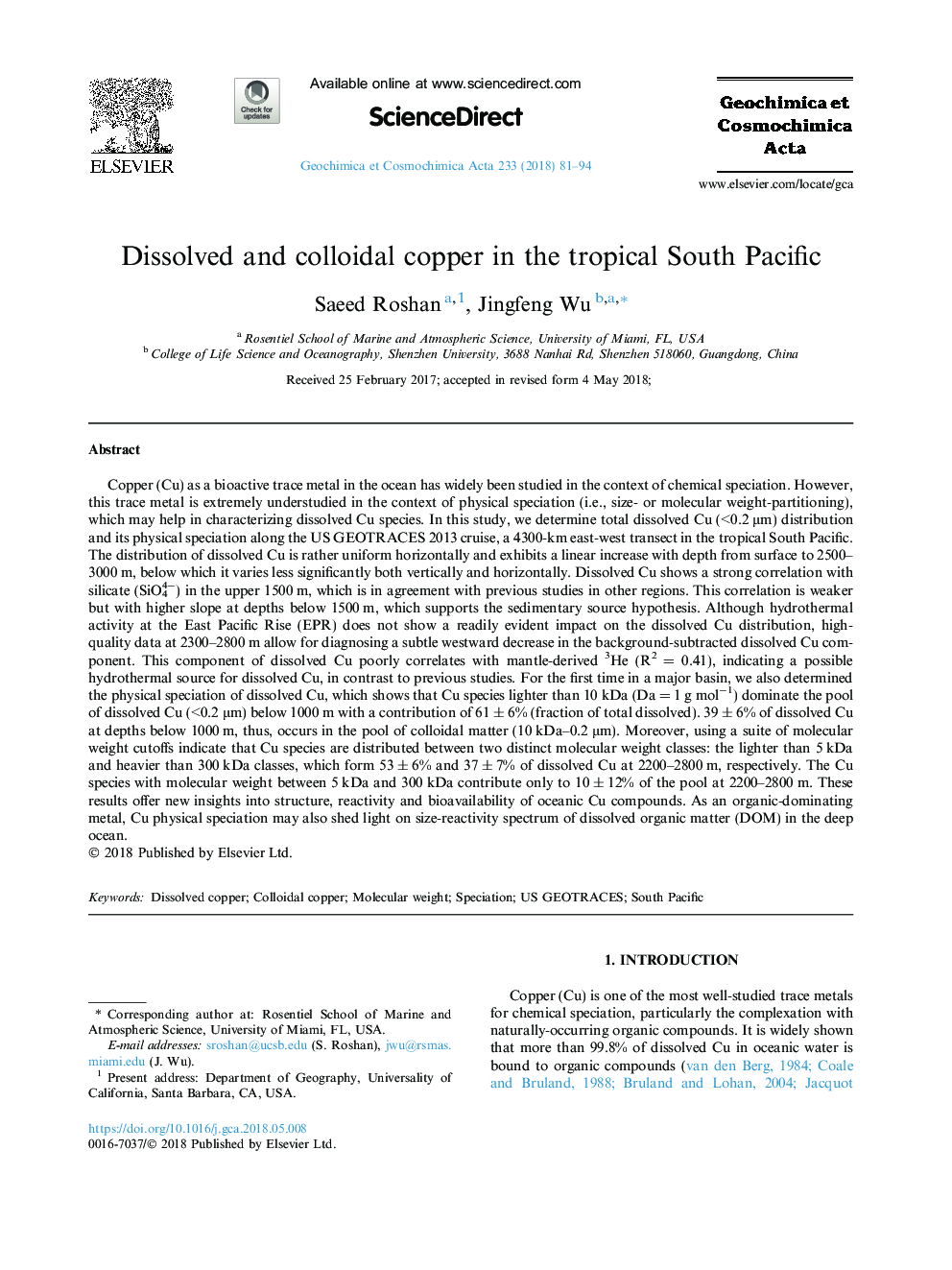| کد مقاله | کد نشریه | سال انتشار | مقاله انگلیسی | نسخه تمام متن |
|---|---|---|---|---|
| 8910712 | 1637924 | 2018 | 14 صفحه PDF | دانلود رایگان |
عنوان انگلیسی مقاله ISI
Dissolved and colloidal copper in the tropical South Pacific
ترجمه فارسی عنوان
مس و حلالیت در مناطق گرمسیری جنوب اقیانوس آرام
دانلود مقاله + سفارش ترجمه
دانلود مقاله ISI انگلیسی
رایگان برای ایرانیان
کلمات کلیدی
موضوعات مرتبط
مهندسی و علوم پایه
علوم زمین و سیارات
ژئوشیمی و پترولوژی
چکیده انگلیسی
Copper (Cu) as a bioactive trace metal in the ocean has widely been studied in the context of chemical speciation. However, this trace metal is extremely understudied in the context of physical speciation (i.e., size- or molecular weight-partitioning), which may help in characterizing dissolved Cu species. In this study, we determine total dissolved Cu (<0.2â¯Î¼m) distribution and its physical speciation along the US GEOTRACES 2013 cruise, a 4300-km east-west transect in the tropical South Pacific. The distribution of dissolved Cu is rather uniform horizontally and exhibits a linear increase with depth from surface to 2500-3000â¯m, below which it varies less significantly both vertically and horizontally. Dissolved Cu shows a strong correlation with silicate (SiO44â) in the upper 1500â¯m, which is in agreement with previous studies in other regions. This correlation is weaker but with higher slope at depths below 1500â¯m, which supports the sedimentary source hypothesis. Although hydrothermal activity at the East Pacific Rise (EPR) does not show a readily evident impact on the dissolved Cu distribution, high-quality data at 2300-2800â¯m allow for diagnosing a subtle westward decrease in the background-subtracted dissolved Cu component. This component of dissolved Cu poorly correlates with mantle-derived 3He (R2 = 0.41), indicating a possible hydrothermal source for dissolved Cu, in contrast to previous studies. For the first time in a major basin, we also determined the physical speciation of dissolved Cu, which shows that Cu species lighter than 10â¯kDa (Daâ¯=â¯1â¯gâ¯molâ1) dominate the pool of dissolved Cu (<0.2â¯Î¼m) below 1000â¯m with a contribution of 61â¯Â±â¯6% (fraction of total dissolved). 39â¯Â±â¯6% of dissolved Cu at depths below 1000â¯m, thus, occurs in the pool of colloidal matter (10â¯kDa-0.2â¯Î¼m). Moreover, using a suite of molecular weight cutoffs indicate that Cu species are distributed between two distinct molecular weight classes: the lighter than 5â¯kDa and heavier than 300â¯kDa classes, which form 53â¯Â±â¯6% and 37â¯Â±â¯7% of dissolved Cu at 2200-2800â¯m, respectively. The Cu species with molecular weight between 5â¯kDa and 300â¯kDa contribute only to 10â¯Â±â¯12% of the pool at 2200-2800â¯m. These results offer new insights into structure, reactivity and bioavailability of oceanic Cu compounds. As an organic-dominating metal, Cu physical speciation may also shed light on size-reactivity spectrum of dissolved organic matter (DOM) in the deep ocean.
ناشر
Database: Elsevier - ScienceDirect (ساینس دایرکت)
Journal: Geochimica et Cosmochimica Acta - Volume 233, 15 July 2018, Pages 81-94
Journal: Geochimica et Cosmochimica Acta - Volume 233, 15 July 2018, Pages 81-94
نویسندگان
Saeed Roshan, Jingfeng Wu,
